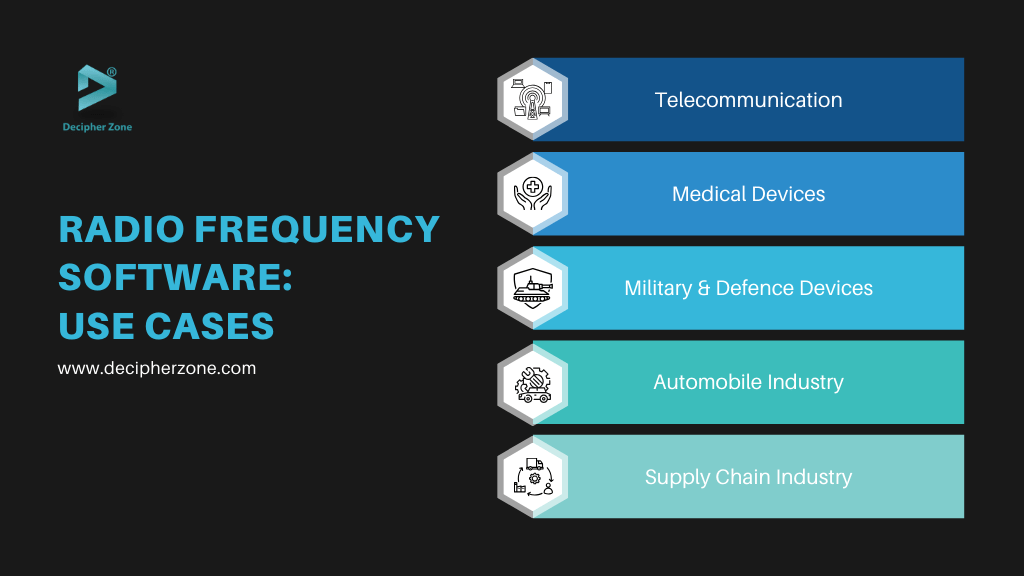Learn how RF software empowers organizations to efficiently oversee wireless devices and their communication networks. Our comprehensive blog spans RF signal processing and essential wireless communication protocols, offering invaluable insights to keep you on the cutting edge of RF software development.
In today’s progressively interconnected digital world, radio frequency (RF) plays a vital role in enabling wireless communication for mobile devices, satellites, Wi-Fi, radio broadcasting, TV, and object detection. As this technology continues to expand, there is an increasing need to plan, design, develop, and launch radio frequency applications that aid in testing and managing RF systems.
Read: Top 12 Skills A Software Developer Should Have
In this blog, our goal is to offer a comprehensive guide to radio frequency software development. We will cover everything from the fundamental concepts of radio frequency systems to advanced techniques to provide valuable insights for those interested in investing in RF software development.
What is a Radio Frequency System?
Radio Frequency (RF) refers to the range of electromagnetic radio waves, which encompasses frequencies from as low as 9 kilohertz (kHz) to as high as 300 gigahertz (GHz). RF systems utilize these radio waves to both transmit and receive signals wirelessly.
These systems typically consist of transmitters, receivers, demodulation, modulation, RF circuits, signal processors, and other components for communication and broadcasting. A wide array of wireless devices leverage RF fields, including Bluetooth devices, Wi-Fi routers, radio and TV broadcasting stations, two-way radios, satellite communication systems, IoT devices, and many more.
Radio Frequency Technology: Use Cases
By now, you may have an idea of the potential applications of RF technology. However, to help you better understand its real-life uses, we have listed the major industries where RF technology and software are utilized.

-
Telecommunication: In this sector, RF software can be used for cellular networks, Wi-Fi, and satellite communications, facilitating seamless and efficient data transfer and communication.
-
Medical Devices: In the medical field, it is used to manage the functioning of advanced devices such as MRI machines and wireless patient monitoring systems, contributing to the diagnosis and treatment of illnesses.
-
Others: Its significance is further evident in military and defense applications, where it is employed in radar systems and communication systems, bolstering national security and strategic operations. Apart from that, RF technology is also crucial in the automobile industry for keyless entry systems and vehicle-to-vehicle communication, enhancing convenience and safety.
Why Invest in Radio Frequency System Software?
RF software offers numerous advantages. It enables the management of wireless communication systems, improves signal performance, enhances security, optimizes spectrum usage, and minimizes interference.
Read: Cloud-Based Software Development
The development of RF software increases communication efficiency by enhancing signal transmission and reception. This results in higher data rates, reduced latency, and more reliable connections.
Refined Radio Frequency (RF) software algorithms are tailored to enhance signal quality by decreasing interference and noise, as well as improving the signal-to-noise ratio (SNR). Consequently, this facilitates clearer and more dependable communication, particularly in challenging and noisy environments.
RF software development also has the potential to cut costs by utilizing software-defined radios (SDRs) and adaptable hardware solutions. This reduces the necessity for specialized hardware and lowers production and maintenance expenses.
In addition to cost-effectiveness, RF software development enables scalability and flexibility, enabling adjustment to evolving requirements and new technologies. Such adaptability is crucial in sectors such as telecommunications and IoT.
Radio Frequency (RF) software development plays a key role in efficiently managing wireless communication systems, optimizing signal performance, maximizing utilization, and enhancing wireless network security. It also aids in minimizing interface issues, ensuring seamless communication across different environments.
Challenges in Developing Radio Frequency Software
Some of the challenges and limitations involved in the development of radio frequency software include:
-
Regulatory Standards: The radio frequency software must comply with regulatory standards such as ETSI in Europe and FCC in the USA, while also adapting to regional and application-specific changes.
-
Power Consumption: The RF software needs to offer power efficiency optimization to enable balanced performance and ensure extended battery life in portable devices.
-
Interference Issues: Another challenge that developers will have to face and address is interference issues. Therefore, developers need to ensure that the RF software can address these issues by using techniques such as frequency hopping, advanced filtering algorithms, and spread spectrum.
-
Complexity of Design: Designing the interface and interactions between the signal path and components is inherently complex. Thus, the hired software development team should be well-versed in RF technology to understand the system complexities to minimize unintended radiation or signal distortion risks while enhancing the software's performance.
Read: The Right Approach to Software Development
Cost of Developing Radio Frequency Software
Creating custom radio frequency software can entail a diverse array of potential expenses, typically ranging from $50,000 to $300,000. The total cost is affected by numerous factors, such as the intricacy of the project, the scale of the software, specific functionalities desired, integration requirements, compatibility needs, adherence to industry standards, the size and expertise of the development team, their hourly rates, the technology stack being utilized, and the estimated duration of the project.
For an accurate cost estimate for developing personalized software that aligns with your business requirements, feel free to contact our specialists to have a detailed discussion about your objectives.
FAQs
-
What is radio frequency technology used for?
Radio Frequency (RF) technology is widely used for sustaining wireless communications including but not limited to broadcasting, radar systems, GPS, satellite communication, and wireless networking. It is also commonly used in RFID (radio-frequency identification) systems for tracking and identifying objects.
-
What are the future implications of radio frequency software development?
As radio frequency technology continues to evolve, the future implications of its software will be significant. The RF software will help industries enhance their wireless communication between devices, improve Internet of Things connectivity, make more efficient use of the radio wave spectrum, and facilitate the development of new RF-based applications across various industries.
-
How to hire developers for RF software development?
When hiring developers for RF software development, it's essential to find individuals with expertise in RF engineering, signal processing, wireless communication protocols, and software development. Consider reaching out to RF software development companies like Decipher Zone and screening candidates with experience in RF design, a grasp of radio frequency principles, familiarity with RF test equipment, and proficiency in programming languages commonly used in RF software development, such as Java, C++, or Python.
Conclusion
So that was all about radio frequency technology and its software development. We hope you found the article interesting and useful for your future endeavors. If you have any questions or would like to learn more about the process and technologies we use to develop excellent radio frequency software, please feel free to contact our team of experts.

